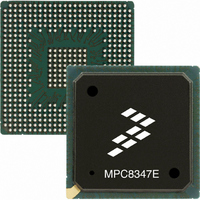MPC8347EVVAJFB Freescale Semiconductor, MPC8347EVVAJFB Datasheet - Page 85

MPC8347EVVAJFB
Manufacturer Part Number
MPC8347EVVAJFB
Description
IC MPU POWERQUICC II 672-TBGA
Manufacturer
Freescale Semiconductor
Series
PowerQUICC II PROr
Specifications of MPC8347EVVAJFB
Processor Type
MPC83xx PowerQUICC II Pro 32-Bit
Speed
533MHz
Voltage
1.2V
Mounting Type
Surface Mount
Package / Case
672-TBGA
Processor Series
MPC8xxx
Core
e300
Data Bus Width
32 bit
Development Tools By Supplier
MPC8349E-MITXE
Maximum Clock Frequency
533 MHz
Maximum Operating Temperature
+ 105 C
Mounting Style
SMD/SMT
I/o Voltage
1.8 V, 2.5 V, 3.3 V
Minimum Operating Temperature
0 C
Core Size
32 Bit
Program Memory Size
64KB
Cpu Speed
533MHz
Embedded Interface Type
I2C, SPI, USB, UART
Digital Ic Case Style
TBGA
No. Of Pins
672
Rohs Compliant
Yes
Lead Free Status / RoHS Status
Lead free / RoHS Compliant
Features
-
Lead Free Status / Rohs Status
Lead free / RoHS Compliant
Available stocks
Company
Part Number
Manufacturer
Quantity
Price
Company:
Part Number:
MPC8347EVVAJFB
Manufacturer:
Freescale Semiconductor
Quantity:
135
Company:
Part Number:
MPC8347EVVAJFB
Manufacturer:
Freescale Semiconductor
Quantity:
10 000
Part Number:
MPC8347EVVAJFB
Manufacturer:
FREESCALE
Quantity:
20 000
20.2.1
An estimation of the chip junction temperature, T
where:
The junction-to-ambient thermal resistance is an industry-standard value that provides a quick and easy
estimation of thermal performance. Generally, the value obtained on a single-layer board is appropriate for
a tightly packed printed-circuit board. The value obtained on the board with the internal planes is usually
appropriate if the board has low power dissipation and the components are well separated. Test cases have
demonstrated that errors of a factor of two (in the quantity T
20.2.2
The thermal performance of a device cannot be adequately predicted from the junction-to-ambient thermal
resistance. The thermal performance of any component is strongly dependent on the power dissipation of
surrounding components. In addition, the ambient temperature varies widely within the application. For
many natural convection and especially closed box applications, the board temperature at the perimeter
(edge) of the package is approximately the same as the local air temperature near the device. Specifying
the local ambient conditions explicitly as the board temperature provides a more precise description of the
local ambient conditions that determine the temperature of the device.
At a known board temperature, the junction temperature is estimated using the following equation:
where:
When the heat loss from the package case to the air can be ignored, acceptable predictions of junction
temperature can be made. The application board should be similar to the thermal test condition: the
component is soldered to a board with internal planes.
Freescale Semiconductor
T
T
R
P
T
T
R
P
A
A
J
J
θ
D
θ
D
JA
JA
= junction temperature (°C)
= junction temperature (°C)
= ambient temperature for the package (°C)
= ambient temperature for the package (°C)
= power dissipation in the package (W)
= power dissipation in the package (W)
MPC8347EA PowerQUICC II Pro Integrated Host Processor Hardware Specifications, Rev. 11
Estimation of Junction Temperature with Junction-to-Ambient
Thermal Resistance
Estimation of Junction Temperature with Junction-to-Board
Thermal Resistance
= junction-to-ambient thermal resistance (°C/W)
= junction-to-ambient thermal resistance (°C/W)
T
T
J
J
= T
= T
A
A
+ (R
+ (R
θ
θ
JA
JA
× P
× P
D
D
)
)
J
, can be obtained from the equation:
J
– T
A
) are possible.
Thermal
85











